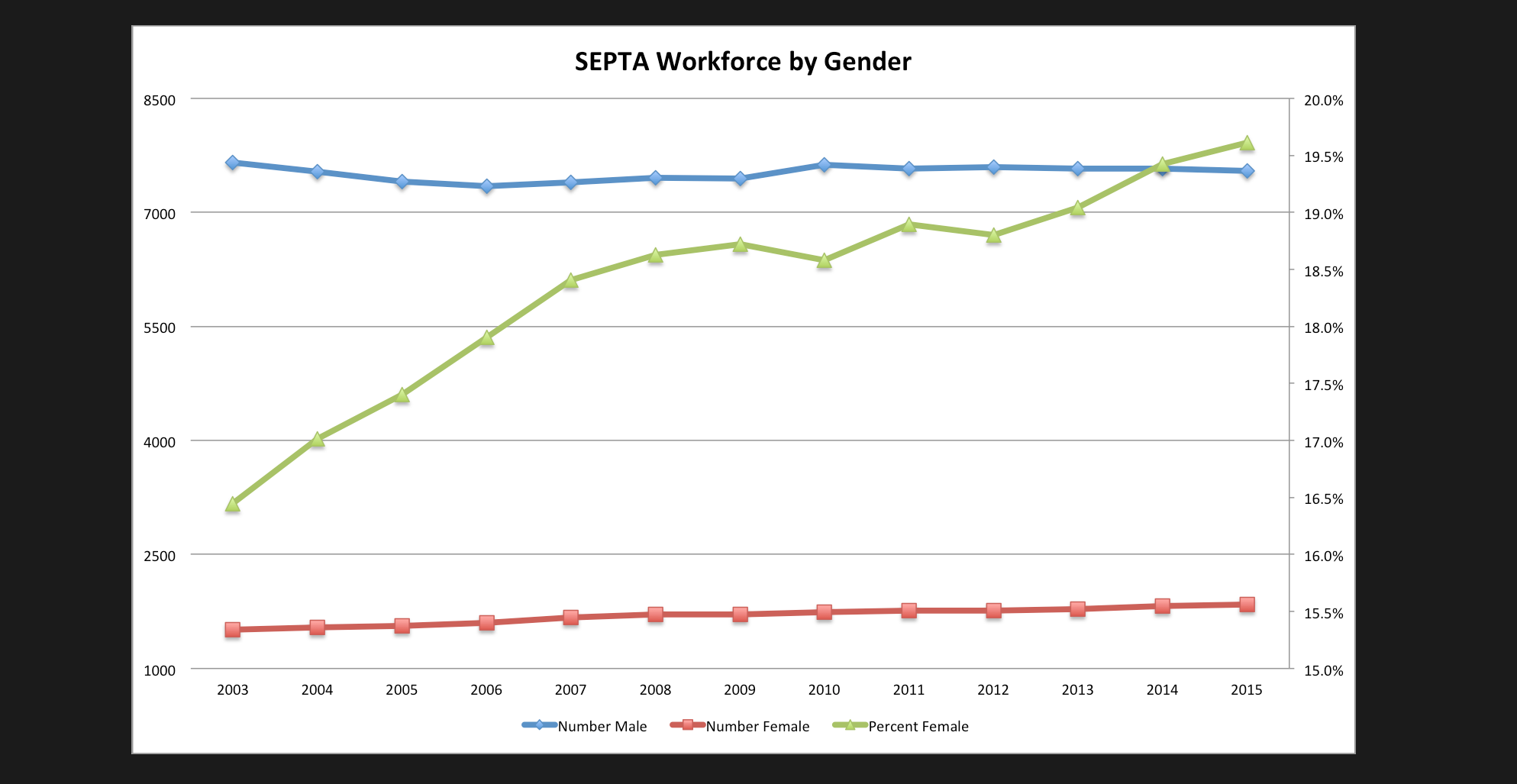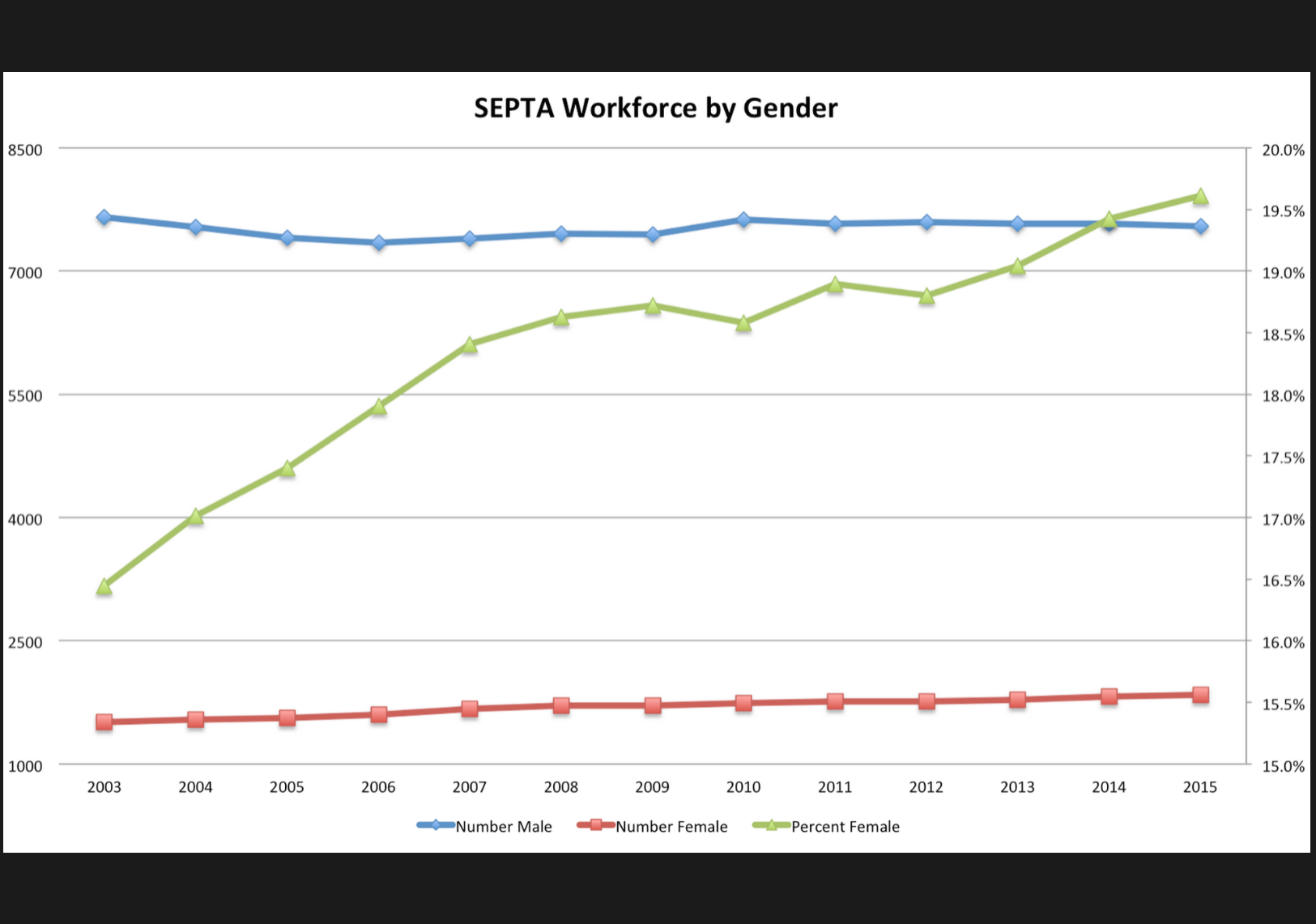What SEPTA’s doing about the lack of women working in public transit

Following PlanPhilly’s somewhat surprising discovery that SEPTA’s ridership apparently is more predominantly female than any other public transportation system in the nation (which themselves were all predominantly female), we decided to look into whether the transit authority’s workforce had a similar gender disparity.
It did! In fact, the disparity was bigger! Only thing is, when it comes to workers instead of riders, it’s men who have the overwhelming numerical advantage: 81 percent of SEPTA workers are male, and just 19 percent are female.
So, what gives? Is SEPTA engaging in discriminatory hiring practices? Are the authority’s recruitment efforts centered around advertisements at the Wing Bowl? Maybe the higher percentage of women riders can be chalked up to male drivers and conductors only picking up the fairer sex? Hardly.
SEPTA is no different from other transit agencies in the area and across the nation in having such a large gap between the number of male and female workers. At work here are forces far more powerful, and more deeply ingrained in our understanding of gender and employment, than anything SEPTA alone can overcome. But it won’t be for lack of trying – SEPTA has instituted a number of hiring and promotion policies focused on improving the balance of women and minority employees.
NO WORSE THAN THE REST OF THEM, WHICH AREN’T VERY GOOD
SEPTA is actually better off than PATCO, which has a 87-13 percent split in workforce. Those numbers improve for the DRPA as a whole – 78 percent male and 22 percent female – likely because many of the general administrative and management employees are considered DRPA employees. Unfortunately, DRPA did not have a breakdown of the gender of employees by type of position readily available.
Amtrak’s numbers are slightly more egalitarian, but still not great: 75.2 percent of the national rail agency workforce is male.
The problem is industry wide, says SEPTA’s Assistant General Manager for Human Resources, Susan Van Buren. “The jobs we are having difficulty recruiting women for are really the non-traditional jobs,” said Van Buren, pointing at engineers, yardmasters, mechanics, and police officers. “These are really, really tough jobs,” she said. “It’s not that women can’t do them, it’s just that the preponderance of women chose not to apply for these jobs.”
The national data from the Bureau of Labor Statistics support Van Buren’s assertion: women represent only 15.5 percent of workers in “transportation and material moving occupations” – a category that includes rail workers, bus drivers, mechanics and engineers, as well as more traditionally female-friendly jobs like flight attendants (80.9 percent female). (These numbers also include some occupations inapposite to this topic, like crane operators, so don’t go citing this article in your PhD dissertation on employment economics and gender.)
The issue is particularly hard in transportation, more so than some other traditionally male fields. The Philadelphia Police Department, for example, is a quarter female. Those numbers put it near the top for large police forces, but DC and Chicago aren’t very far behind with forces that are both 23 percent female. Ten percent of SEPTA police officers are women. Nationally, women make up 15.3 percent of police officers and detectives, which is about even with transportation workers.
IS THIS SEXISM, OR SOMETHING MORE SUBTLE?
While many would assume that some sort of institutional sexism is to blame, the more likely culprit is something far more subtle and pernicious – unconscious biases.
What’s the difference between blatant sexism and unconscious bias? Well, remember that Super Bowl commercial about running and throwing like a girl? Unconscious bias is basically that, only without anyone trying to sell feminine hygiene products.
In his book The Hidden Brain, Shankar Vedantam shares an anecdote about his daughter to explain how these unconscious biases and heuristics – what he calls the hidden brain – influence our thinking. Her favorite game to play with Daddy was “doctor” and whenever they played, he was the doctor and she was a nurse. Sometimes, she was willing to be a doctor, too, but her father was never allowed to be the nurse. That violated her toddler understanding of the world informed by thousands of unconscious associations: “I finally asked her why nurses had to be female,” Vedantam writes, “and she explained, with the calm logic of a child, that she had never seen a storybook where a man was a nurse.”
As Vedantam explicates, toddlers offer a window into the hidden brain because they haven’t quite learned yet to reason and understand social norms like older children and adults. That Vedantam’s daughter had such an unenlightened view about male nurses can be ascribed to her developing mind trying to discern unspoken rules about the world – who gets to make rules (adults), whether it is rude to spit on people (it is) and whether men can be nurses (…no?). When kids get these norms wrong, its not that they are awful little people, it’s that a less-than-egalitarian society has presented a kangaroo court of sorts, all but begging them to reach the wrong conclusion.
Adults understand that men can be nurses because, as we mature, reason takes control and override these false associations imprinted on our unconsciousness. But just because we can reason away and around these buried biases doesn’t mean that they aren’t still there and controlling how we often act.
Even when we target men for nursing jobs – or women for public transportation jobs – it’s hard to overcome these long held, socially ingrained, unwitting preconceptions. For most of us, jobs simply don’t even show up on our mental radar if we are the “non-traditional” gender. I suspect many women completely ignore SEPTA’s and PATCO’s job openings for train conductors and janitors, giving them the same amount of thoughtful consideration a college-bound arcophobe would give Embry-Riddle.
And that’s why these biases are so pernicious and difficult to address. While someone who fears heights refusing to give flight school a second’s thought makes plenty of rational sense, qualified women skipping SEPTA’s help wanted ads simply doesn’t. But we rarely ask someone why she didn’t apply for a given job. That’s like asking your date why she didn’t ask for a beer after she ordered a white wine, and she isn’t about to contemplate the decision much, either – she just did, almost instinctually, and you both move on without the need for deliberate reflection on the choice. In other words, we aren’t individually actively asking our rationality to counteract these biases, and neither is anyone else.
And while we might wish we treated jobs and drinks differently – given their relatively different levels of importance to most non-alcoholics – the sad fact is we really don’t.
If you ask a woman whether its okay for engineers or electricians to be female, she will almost undoubtedly say yes, because her rationality can overrule the unthinking bias. But the biases will operate in the background, as the default operating system, until they are proactively overridden. And when we’re mindlessly scanning job listings for something that just so happens to maybe catch the eye, we will look at the “non-traditional” jobs, but we won’t actually see them, because our biases are in control, limiting our choices and freeing up our rational, thoughtful brain for more pressing questions, like whether unemployed you really needs to put pants on today.
As a result, conditioned as we are by subtle, pernicious biases shaped by hundreds of tiny, often unintentional, observed prejudices repeated thousands of times by the media – your mom was right, TV really does rot your brain – we skip over perfectly good options, regardless of how enlightened and forward-thinking we might be consciously. And so, as a result men are less likely to go into teaching and women are less likely to go into public transportation.
SEPTA is trying to combat this problem on their end with specific hiring efforts, targeting women’s groups and the such with their online recruitment. To overcome some of the self-selection biases – where men are more likely to apply for a promotion than women, even when they are less qualified – SEPTA even started sending letters to qualified women employees who didn’t submit their name for promotion consideration, encouraging them to apply.
But even at the management levels, things are tough. SEPTA is made up of a lot of engineers, and women still aren’t joining the Science Technology Engineering and Math (STEM) fields as much as men. And even those who begin their collegiate careers in STEM aren’t sticking with it as much as their male peers. The aforementioned biases, a dearth of female role models, and enough – too many, I should say – instances of actual, overt sexism all contribute to that underlying problem, which in turn causes such large gender gaps at transportation authorities. And all those issues don’t suddenly disappear upon graduation – in STEM fields, male-dominated labs and classrooms turn into male-dominated work yards and boardrooms
SEPTA is fighting against the lack of role models problem by creating “Women in Transit”, a group with a mission “to develop women at SEPTA through strong leadership, mutual support and respect.” It’s also developing a career center aimed at entry level and junior level employees, modeled after a similar program that currently exists for senior level positions (mentoring alone, probably won’t do the trick, though). And while pushing against the massive boulder of gender disparity in media’s representation of certain jobs probably wasn’t the end goal of this series of recruitment videos for their engineering and architecture department, they do emphasize diversity, so… progress?
Whether all the efforts will work remains to be seen, but the numbers suggest significant improvement over the last few years: since 2003, women have jumped from just 16.4 percent to 19.6 percent. Put it a different way: there are 332 more women today and 120 fewer men.

WHYY is your source for fact-based, in-depth journalism and information. As a nonprofit organization, we rely on financial support from readers like you. Please give today.



